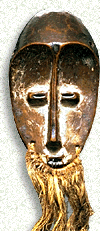




Mbangu mask. Central Pende. Bandundu, Zaïre.
Wood, pigments, fibre.
© Africa-Museum, Tervuren

|
|

WHAT IS IT?
This mask falls into the category of mbuya masks, which are used to
represent different characters. This one, mbangu, represents a
cursed man, someone who has been struck by sickness or has had deformities
cast upon him by sorcerers. Although his face shows signs of nerve
paralysis, features characteristic of the katundu style in the
Pende region are still apparent: note the eyebrow line in the shape of an
inverted "W"; the triangular nose and pointed chin.
WHERE DOES IT COME
FROM?
The mask comes from the Central Pende region in the Bandundu province, south
of Zaïre.
WHAT MESSAGE DOES IT
CONVEY?
The mask shows that a curse can strike — like lightning — without
warning. Onlookers see one of their own kind who has been rendered
powerless, unable to shake off the curse that has struck him.
HOW IS IT USED?
In the past, mbuya masks were used to mark the end of circumcision
rituals but today they play a more festive role. Within a group, actors take
turns to dance and set the stage for different characters to appear: the
chief, the lawmaker, the hunter, the village flirt, the priest, the
witchdoctor, etc. Each is characterized by a specific dance step and a
distinct rhythm. Mbangu appears as a hunchback who has been struck
by an arrow. The masked dancer develops the dance in concert with the
audience, who mock him while at the same time chanting an accompaniment.
|


Biombo mask. West Kasai, Zaïre. Wood,
pigments, headed nails.
© Africa-Museum, Tervuren

|
|
HOW DO MASKS WORK?
Many African societies see masks as mediators between the living world and
the supernatural world of the dead and other entities. When carried or worn
during a dance, the mbangu mask does not exert magic powers.
However, certain mbuyu masks, such as those representing the chief,
the hunter and the female mask Pota, have the power to heal when worn during
a dance performed around a sick person. Someone healed in this way might
carry a miniature ivory mask, a replica of the mask that healed him.
|


Lukwakongo mask. Lega. Kivu, Zaïre. Wood,
pigments, fibre.
© Africa-Museum, Tervuren

|
|
HOW ARE MASKS MADE?
In producing a mask, a sculptor's aim is to depict a person's psychological
and moral characteristics rather than provide a portrait. The sculptor
begins by cutting a piece of wood and leaving it to dry in the sun; if it
cracks, it cannot be used for a mask. African sculptors see wood as a
complex living material and believe each piece can add its own feature to
their work. Having made certain the wood is suitable, the sculptor begins,
using an azde to carve the main features, a chisel to work on details and a
rough leaf to sand the piece. He then paints the mask with pigments such as
charcoal (to give a black colour), powders made from vegetable matter or
trees (for ochre/earth tones) or mineral powders like clay (to give a white
colour).
In this mask, vegetable fibres have been used for hair and a beard. The
black eyelids have smallpox marks on them and the black side of his face
suggests that a fit of epilepsy caused him to fall into the fire. Note that
unlike our own cultures, African peoples often symbolize death by the colour
white rather than black. At the same time, many African cultures see white
as the colour that links them to their ancestors, and it can therefore have
a positive meaning.
|


Pendant. Hungaan. Bandundu, Zaïre. Ivory.
© Africa-Museum, Tervuren

|
|
WHAT PURPOSE DOES THIS TYPE OF MASK
SERVE?
Mbuya masks have three main functions. They can:
- play a therapeutic or healing role (some masks can be carved as ivory
miniatures and worn as pendants);
- act as a mirror of society (a mask can represent, for example, the good
fortune of a woman who has given birth in her later years); or
- be used for entertainment in non-ritual festivities (a more modern
use).
|

|